Development of an Educational Gamification Strategy to Enhance the Food Safety Practices of Family Farmers in Public Food Markets of Northeast Brazil: A Case Study
Abstract
1. Introduction
2. Materials and Methods
2.1. Study Area and Participants
2.2. Assessment of GMP in Public Food Markets
2.3. Assessment of Knowledge of Family Farmers Regarding Food Safety Practices
2.4. Training of Family Farmers
2.5. Microbiological Analysis of Foods Commercialized by Family Farmers in Public Food Markets
2.6. Data Processing and Statistical Analysis
3. Results
3.1. Sociodemographic Profile of Family Farmers and Diversity of Products Commercialized in Public Food Markets
3.2. Assessment of GMP in Public Food Markets
3.3. Training of Family Farmers and Assessment of Food Safety Practices Knowledge
3.4. Microbiological Parameters of Foods Commercialized by Family Farmers in Public Food Markets
4. Discussion
5. Conclusions
Author Contributions
Funding
Data Availability Statement
Conflicts of Interest
References
- Löhr, K.; Mugabe, P.; Turetta, A.P.D.; Steinke, J.; Lozano, C.; Bonatti, M.; Eufemia, L.; Ito, L.H.; Konzack, A.; Kroll, S.; et al. Assessing impacts of COVID-19 and their responses among smallholder farmers in Brazil, Madagascar and Tanzania. Outlook Agric. 2022, 51, 460–469. [Google Scholar] [CrossRef]
- Tittonell, P.; Fernandez, M.; Mujtar, V.E.E.; Preiss, P.V.; Sarapura, S.; Laborda, L.; Mendonça, M.A.; Alvarez, V.E.; Fernandes, G.B.; Petersen, P.; et al. Emerging responses to the COVID-19 crisis from family farming and the agroecology movement in Latin America—A rediscovery of food, farmers and collective action. Agric. Syst. 2021, 190, 103098. [Google Scholar] [CrossRef] [PubMed]
- Gala, P.; Camargo, J.; Freitas, E. The Economic Commission for Latin America and the Caribbean (ECLAC) was right: Scale-free complex networks and core-periphery patterns in world trade. Camb. J. Econ. 2018, 42, 633–651. [Google Scholar] [CrossRef]
- Mchiza, Z.; Hill, J.; Steyn, N. Foods Currently Sold by Street Food Vendors in the Western Cape, South Africa, Do not foster Good Health. In Fast Foods: Consumption Patterns, Role of Globalization and Health Effects; Sanford, M.G., Ed.; Nova Science Publishers Inc.: Hauppauge, NY, USA, 2014; Chapter 4; pp. 91–118. [Google Scholar]
- FAO/WHO. COVID-19 and Smallholder Producers’ Access to Markets; Food and Agriculture Organization of the United Nations: Rome, Italy, 2020. [Google Scholar]
- Marutha, K.J.; Chelule, P.K. Safe food handling knowledge and practices of street food vendors in Polokwane Central Business District. Foods 2020, 9, 1560. [Google Scholar] [CrossRef]
- Cotter, S.; Yamamoto, J.; Stevenson, C. A systematic characterization of food safety training interventions using the analyze, design, develop, implement, evaluate (ADDIE) instructional design framework. Food Cont. 2023, 145, 109415–109429. [Google Scholar] [CrossRef]
- Silva, J.N.; Baliza, M.D.; Freitas, F.; Cruza, E.S.; Camilo, V.M.A.; Silva, I.M.M. Genotypical characterization of thermotolerant coliforms isolated from food produced by a solidarity economic venture of Bahia (Brazil). Braz. J. Biol. 2021, 81, 189–194. [Google Scholar] [CrossRef]
- Aleksic, B.; Djekic, I.; Miocinovic, J.; Miloradovic, Z.; Savic–Radovanovic, R.; Zdravkovic, N.; Smigic, N. The hygienic assessment of dairy products’ selling places at open markets. Food Cont. 2023, 148, 109628–109641. [Google Scholar] [CrossRef]
- Brazil—Resolução RDC n° 216, de 15 de Setembro de 2004. Available online: https://bvsms.saude.gov.br/bvs/saudelegis/anvisa/2004/res0216_15_09_2004.html (accessed on 30 January 2023).
- Trafialek, J.; Drosinos, E.H.; Laskowski, W.; Jakubowska-Gawlik, K.; Tzamalis, P.; Leksawasdi, N.; Surawang, S.; Kolanowski, W. Street food vendors’ hygienic practices in some Asian and EU countries—A survey. Food Cont. 2018, 85, 212–222. [Google Scholar] [CrossRef]
- Rosales, A.P.; Linnemann, A.R.; Luning, P.A. Food safety knowledge, self-reported hygiene practices, and street food vendors’ perceptions of current hygiene facilities and services—An Ecuadorean case. Food Cont. 2023, 144, 109377–109389. [Google Scholar] [CrossRef]
- Souza, A.C.F.; Souza, J.F.; Mendes, I.G. Microbiological evaluation of frozen fruit pulps commercialized in public markets of the city of Macapá, Amapá. Res. Soc. Dev. 2020, 9, 1919–1926. [Google Scholar]
- Insfran-Rivarola, A.; Tlapa, D.; Limon-Romero, J.; Baez-Lopez, Y.; Ackerman, M.M.; Soto, K.A.; Ontiveros, S. Systematic review and meta-analysis of the effects of food safety and hygiene training on food handlers. Foods 2020, 9, 1169. [Google Scholar] [CrossRef]
- Estimates of the Global Burden of Foodborne Diseases; Foodborne Diseases Burden Epidemiology Reference Group 2007–2015. Available online: https://www.epa.gov/dwstandardsregulations/drinking-water-contaminant-human-health-effects-information#dw-standards (accessed on 27 April 2021).
- Callejón, R.M.; Rodríguez-Naranjo, M.I.; Ubeda, C.; Hornedo-Ortega, R.; Garcia-Parrilla, M.C.; Troncoso, A.M. Reported foodborne outbreaks due to fresh produce in the United States and European Union: Trends and causes. Foodborne Pathog. 2015, 12, 32–38. [Google Scholar] [CrossRef]
- Hanson, L.A.; Zahn, E.A.; Wild, S.R.; Döpfer, D.; Scott, J.; Stein, C. Estimating global mortality from potentially foodborne diseases: An analysis using vital registration data. Popul. Health Metr. 2012, 10, 5. [Google Scholar] [CrossRef]
- Faour-Klingbeil, D.; Kuri, V.; Todd, E. Investigating a link of two different types of food business management to the food safety knowledge, attitudes, and practices of food handlers in Beirut, Lebanon. Food Cont. 2015, 55, 166–175. [Google Scholar] [CrossRef]
- Che-Has, S.; Afifah-Jaafar, S.; Tuan-Chilek, T. An assessment on pre-and post-food hygiene training on food safety’s Kap level among food handlers in Kuala Terengganu and Kuala Nerus. Malays. Ann. Appl. Biol. 2018, 47, 61–69. [Google Scholar]
- Hardstaff, J.L.; Clough, H.E.; Lutje, V.; McIntyre, K.M.; Harris, J.P.; Garner, P.; O’Brien, S.J. Foodborne and food-handler Norovirus outbreaks: A systematic review. Foodborne Pathog. 2018, 15, 589–597. [Google Scholar] [CrossRef]
- McIntyre, L.; Vallaster, L.; Wilcott, L.; Henderson, S.B.; Kosatsky, T. Evaluation of food safety knowledge, attitudes and self-reported hand washing practices in FOODSAFE trained and untrained food handlers in British Columbia, Canada. Food Cont. 2013, 30, 150–156. [Google Scholar] [CrossRef]
- Hwang, J.; Lee, J.S.; Kim, H. Perceived innovativeness of drone food delivery services and its impacts on attitude and behavioral intentions: The moderating role of gender and age. Int. J. Hosp. Manag. 2019, 81, 94–103. [Google Scholar] [CrossRef]
- Hwang, J.; Park, S.; Kim, I. Understanding motivated consumer innovativeness in the context of a robotic restaurant: The moderating role of product knowledge. Hosp. Tour. Manag. 2020, 44, 272–282. [Google Scholar] [CrossRef]
- Brazil—Resolução RDC n° 275, de 21 de Outubro de 2002. Available online: https://www.gov.br/agricultura/pt-br/assuntos/inspecao/produtos-vegetal/legislacao-1/biblioteca-de-normas-vinhos-e-bebidas/resolucao-rdc-no-275-de-21-de-outubro-de-2002.pdf/view (accessed on 30 January 2023).
- Gruenfeldova, J.; Domijan, K.; Walsh, C. A study of food safety knowledge, practice and training among food handlers in Ireland. Food Cont. 2019, 105, 131–140. [Google Scholar] [CrossRef]
- Malavi, A.N.; Abong, G.O.; Muzhingi, T. Effect of food safety training on behavior change of food handlers: A case of orange-fleshed sweet potato purée processing in Kenya. Food Cont. 2021, 119, 107500. [Google Scholar] [CrossRef] [PubMed]
- FAO/WHO. Food Quality and Safety Systems—A Training Manual on Food Hygiene and the Hazard Analysis and Critical Control Point (HACCP) System; FAO, Food Quality and Standards Service Food and Nutrition Division: Rome, Italy, 1998. [Google Scholar]
- FAO/WHO. Foodborne Disease Outbreaks: Guidelines for Investigation and Control. Available online: https://www.who.int/publications/i/item/9789241547222 (accessed on 30 January 2023).
- FAO/WHO. Codex and the SDGs—How Participation in Codex Alimentarius Supports the 2030 Agenda for Sustainable Development. Available online: https://www.fao.org/3/cb0222en/cb0222en.pdf (accessed on 30 January 2023).
- Brazil—Instrução Normativa n° 161, de 1° de Julho de 2022. Available online: http://antigo.anvisa.gov.br/documents/10181/2718376/IN_161_2022_.pdf/b08d70cb-add6-47e3-a5d3-fa317c2d54b2 (accessed on 30 January 2023).
- American Public Health (APHA). Compendium for the Microbiological Examination of Foods; American Public Health: Washington, DC, USA, 2015. [Google Scholar]
- ISO 6579:2002; Microbiology of Food and Animal Feeding Stuffs—Horizontal Method for the detection of Salmonella spp. International Standardization Organization: Geneva, Switzerland, 2002.
- ISO 6888-1:1999/AMD 1:2003; Microbiology of Food and Animal Feeding Stuffs—Horizontal Method for the Enumeration of Coagulase-Positive Staphylococci (Staphylococcus aureus and Other Species)—Part 1: Technique Using Baird-Parker Agar Medium—Amendment 1: Inclusion of Precision Data. International Standardization Organization: Geneva, Switzerland, 2003.
- Pessotto, A.P.; Costa, C.; Schwinghamer, T.; Colle, G.; Corte, V.F.D. Factors influencing intergenerational succession in family farm businesses in Brazil. Land Use Policy 2019, 87, 104045. [Google Scholar] [CrossRef]
- Giller, K.E.; Delaune, T.; Silva, J.V.; Descheemaeker, K.; van de Ven, G.; Schut, A.G.; Wijk, M.V.; Hammond, J.; Hochman, Z.; Taulya, G.; et al. The future of farming: Who will produce our food? Food Secur. 2021, 13, 1073–1099. [Google Scholar] [CrossRef]
- Herrera, G.P.; Lourival, R.; Costa, R.B.; Mendes, D.R.F.; Moreira, T.B.S.; Abreu, U.B.P.; Constantino, M. Econometric analysis of income, productivity and diversification among smallholders in Brazil. Land Use Policy 2018, 76, 455–459. [Google Scholar] [CrossRef]
- Kothe, C.I.; Schild, C.H.; Tondo, E.C.; da Silva Malheiros, P. Microbiological contamination and evaluation of sanitary conditions of hot dog street vendors in Southern Brazil. Food Cont. 2016, 62, 346–350. [Google Scholar] [CrossRef]
- Letuka, P.; Nkhebenyane, S.; Thekisoe, O. Assessment of food safety knowledge, attitudes and practices among street food vendors and consumers’perceptions of street food vending in Maseru Lesotho. Preprints 2019, 1, 1–9. [Google Scholar]
- Singh, A.K.; Singh, N.P.; Chaturvedani, A.K. Food Safety and Hygiene Practices among Street Food Vendors in Noida, Uttar Pradesh, India. Int. J. Curr. Microbiol. App. Sci. 2018, 7, 2340–2347. [Google Scholar] [CrossRef]
- Choudhury, M.; Mahanta, L.B.; Goswami, J.S.; Mazumder, M.D. Will capacity building training interventions given to street food vendors give us safer food? A cross-sectional study from India. Food Cont. 2011, 22, 1233–1239. [Google Scholar] [CrossRef]
- Da Silva, S.A.; Cardoso, R.C.V.; Góes, J.T.W.; Santos, J.N.; Ramos, F.P.; Bispo de Jesus, R.; Sabá do Vale, R.; Teles da Silva, P.S. Street food on the coast of Salvador, Bahia, Brazil: A study from the socioeconomic and food safety perspectives. Food Cont. 2014, 40, 78–84. [Google Scholar] [CrossRef]
- Seaman, P. Food hygiene training: Introducing the food hygiene training model. Food Cont. 2010, 21, 381–387. [Google Scholar] [CrossRef]
- Abushelaibi, A.M.; Jobe, B.; Afifi, H.S.; Mostafa, B.E.; Murad, A.A.; Mohammed, A.K. Evaluation of the effect of person-in-charge (PIC) program on knowledge and practice change of food handlers in Dubai. Food Cont. 2015, 50, 382–392. [Google Scholar] [CrossRef]
- Fielding, L.; Ellis, L.; Clayton, D.; Peters, A. An evaluation of process specific information resources, aimed at hazard analysis, in small and medium enterprises in food manufacturing. Food Cont. 2011, 22, 1171–1177. [Google Scholar] [CrossRef]
- Mohammad, Z.H.; Yu, H.; Neal, J.A.; Gibson, K.E.; Sirsat, S.A. Food safety challenges and barriers in southern United States farmers markets. Foods 2020, 9, 12. [Google Scholar] [CrossRef]
- Husain, N.R.; Muda, W.M.; Jamil, N.I.; Hanafi, N.N.; Rahman, A.R. Effect of food safety training on food handlers’ knowledge and practices: A randomized controlled trial. Br. Food J. 2016, 118, 795–808. [Google Scholar] [CrossRef]
- Rossi, M.S.C.; Stedefeldt, E.; Cunha, D.T.; Rosso, V.V. Food safety knowledge, optimistic bias and risk perception among food handlers in institutional food services. Food Cont. 2017, 73, 681–688. [Google Scholar] [CrossRef]
- Auad, L.I.; Ginani, V.C.; Stedefeldt, E.; Nakano, E.Y.; Nunes, A.C.S.; Zandonadi, R.P. Food safety knowledge, attitudes, and practices of Brazilian food truck food handlers. Nutrients 2019, 11, 1784. [Google Scholar] [CrossRef]
- Da Cunha, D.T.; Stedefeldt, E.; de Rosso, V.V. The role of theoretical food safety training on Brazilian food handlers’ knowledge, attitude and practice. Food Cont. 2014, 43, 167–174. [Google Scholar] [CrossRef]
- Ma, L.; Chen, H.; Yan, H.; Wu, L.; Zhang, W. Food safety knowledge, attitudes, and behavior of street food vendors and consumers in Handan, a third-tier city in China. BMC Public Health 2019, 19, 1128. [Google Scholar] [CrossRef]
- Ghali-Mohammed, I.; Odetokun, I.A.; Raufu, I.A.; Alhaji, N.B.; Adetunji, V.O. Prevalence of Escherichia coli O157 isolated from marketed raw cow milk in Kwara State, Nigeria. Sci. Afr. 2023, 19, 2468–2476. [Google Scholar] [CrossRef]
- Eslahi, A.V.; Olfatifar, M.; Zaki, L.; Saryazdi, A.K.; Barikbin, F.; Maleki, A.; Abdoli, A.; Badri, M.; Karanis, P. Global prevalence of intestinal protozoan parasites among food handlers: A systematic review and meta-analysis. Food Cont. 2023, 145, 100–106. [Google Scholar] [CrossRef]
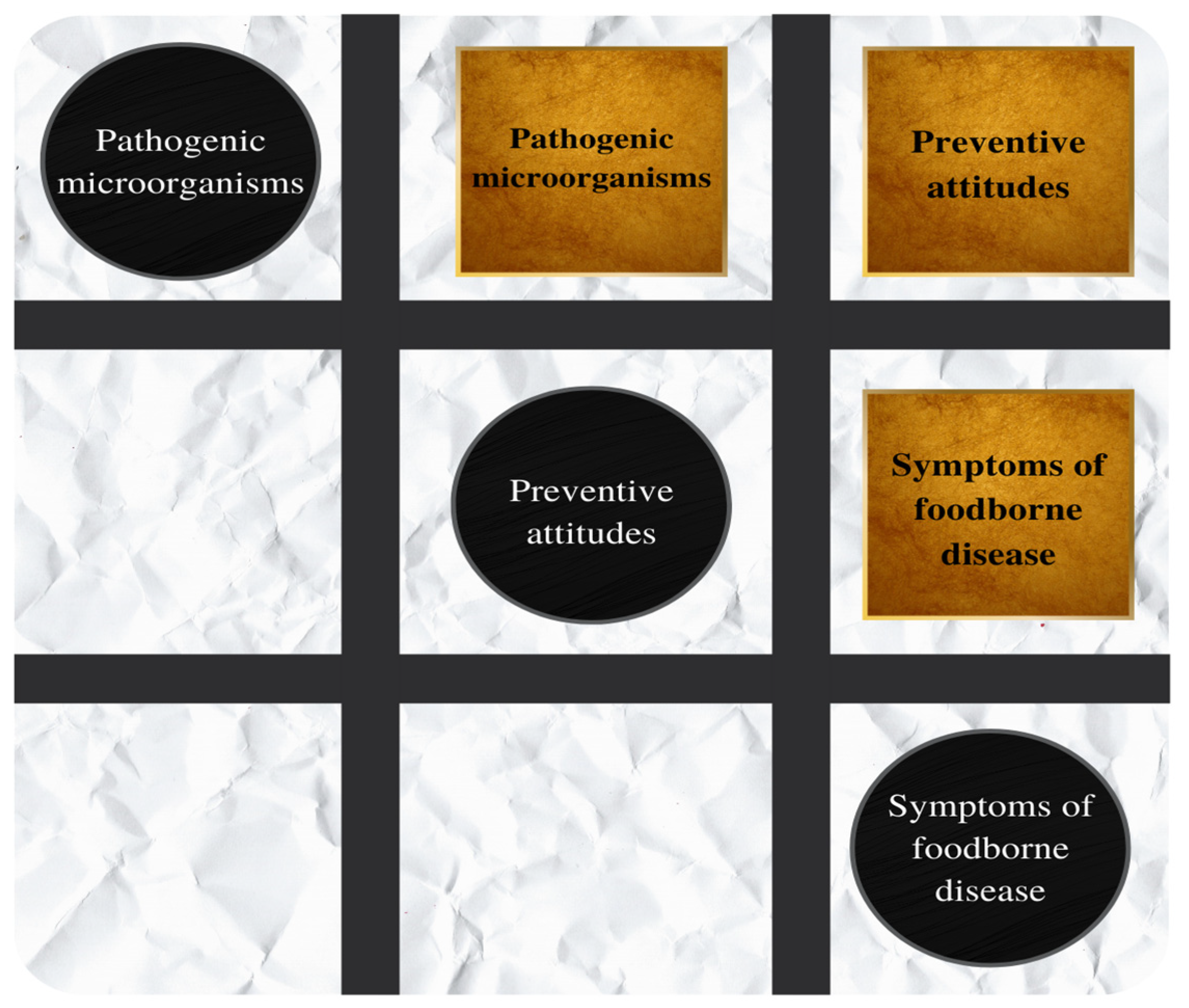
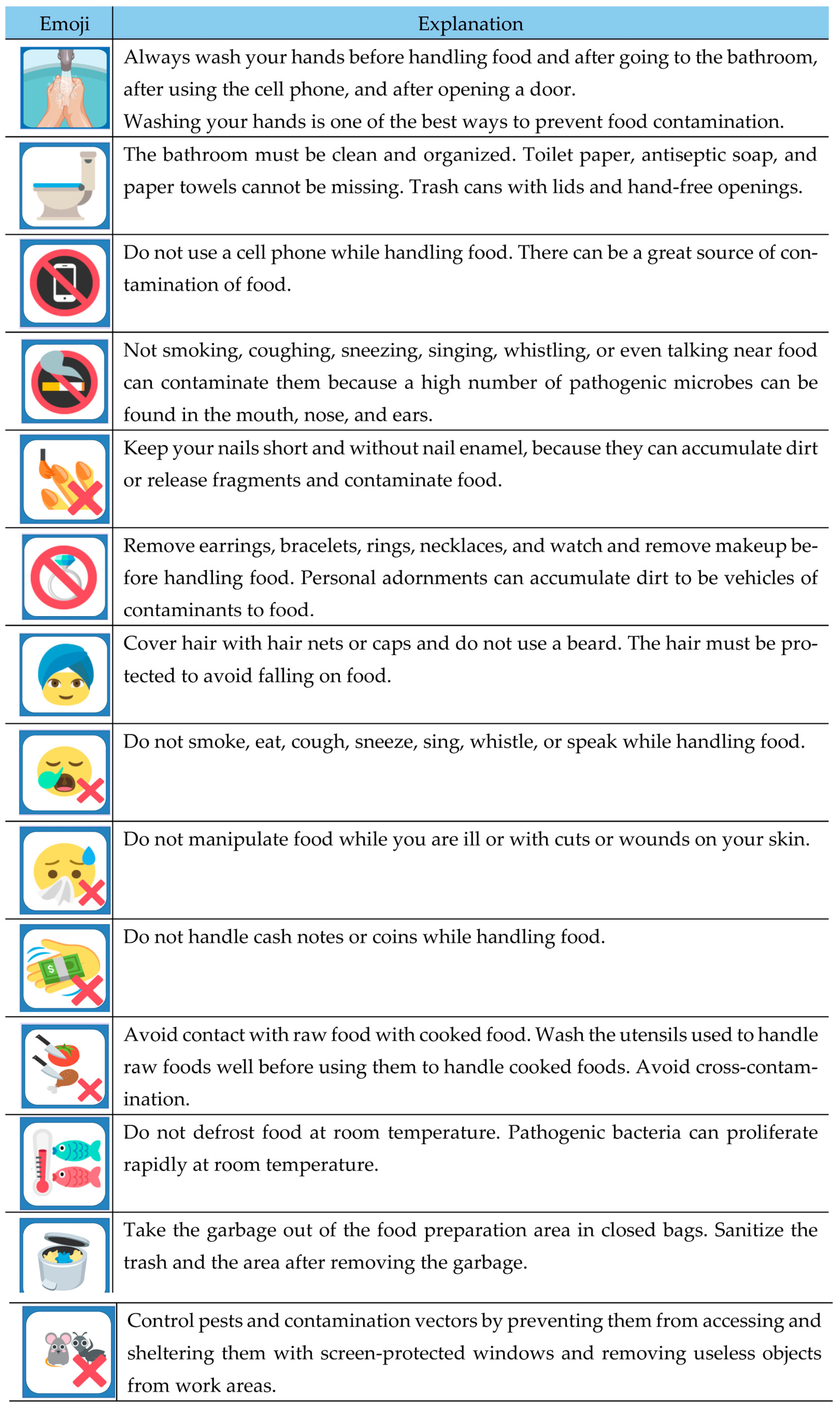
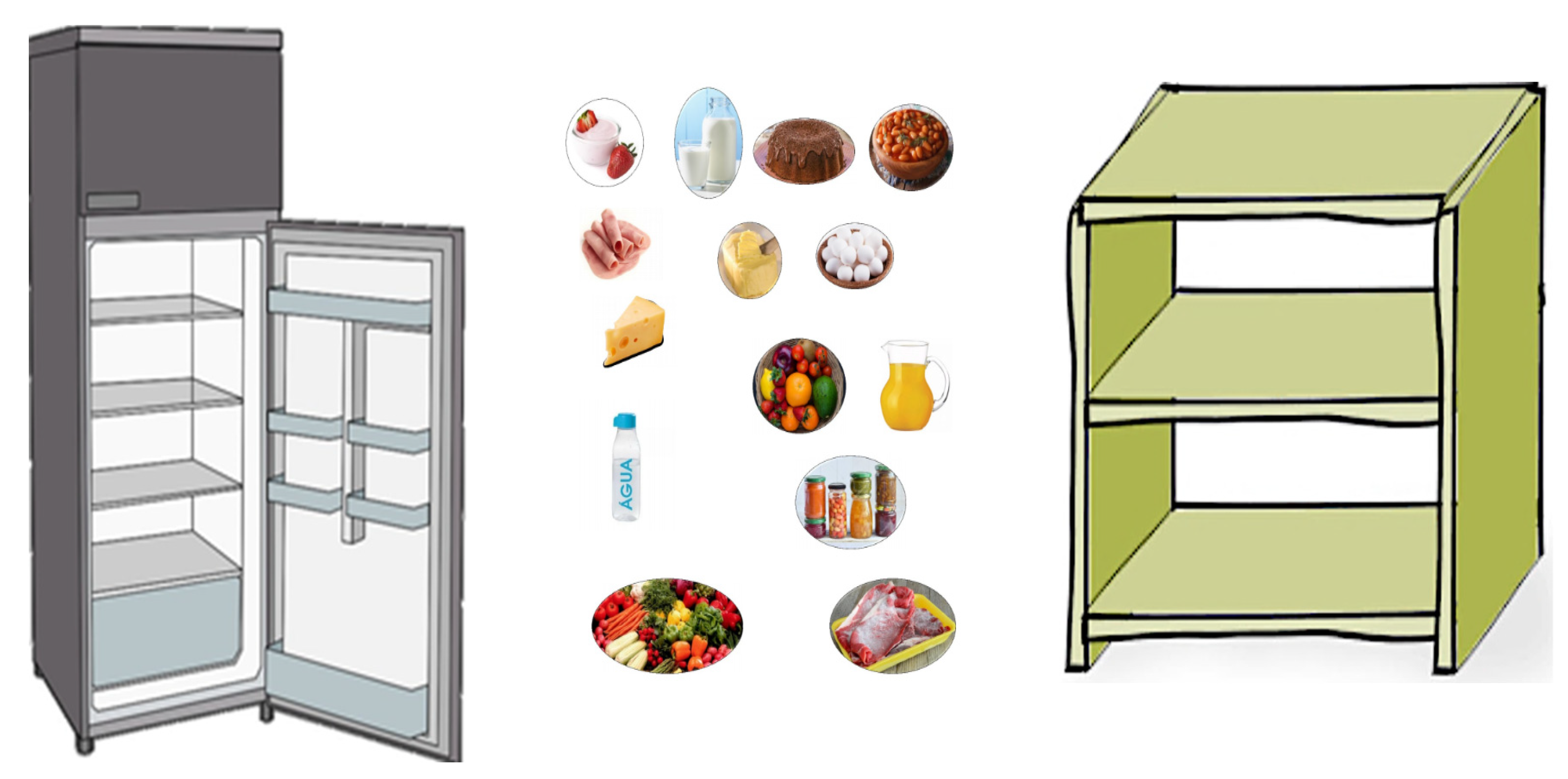
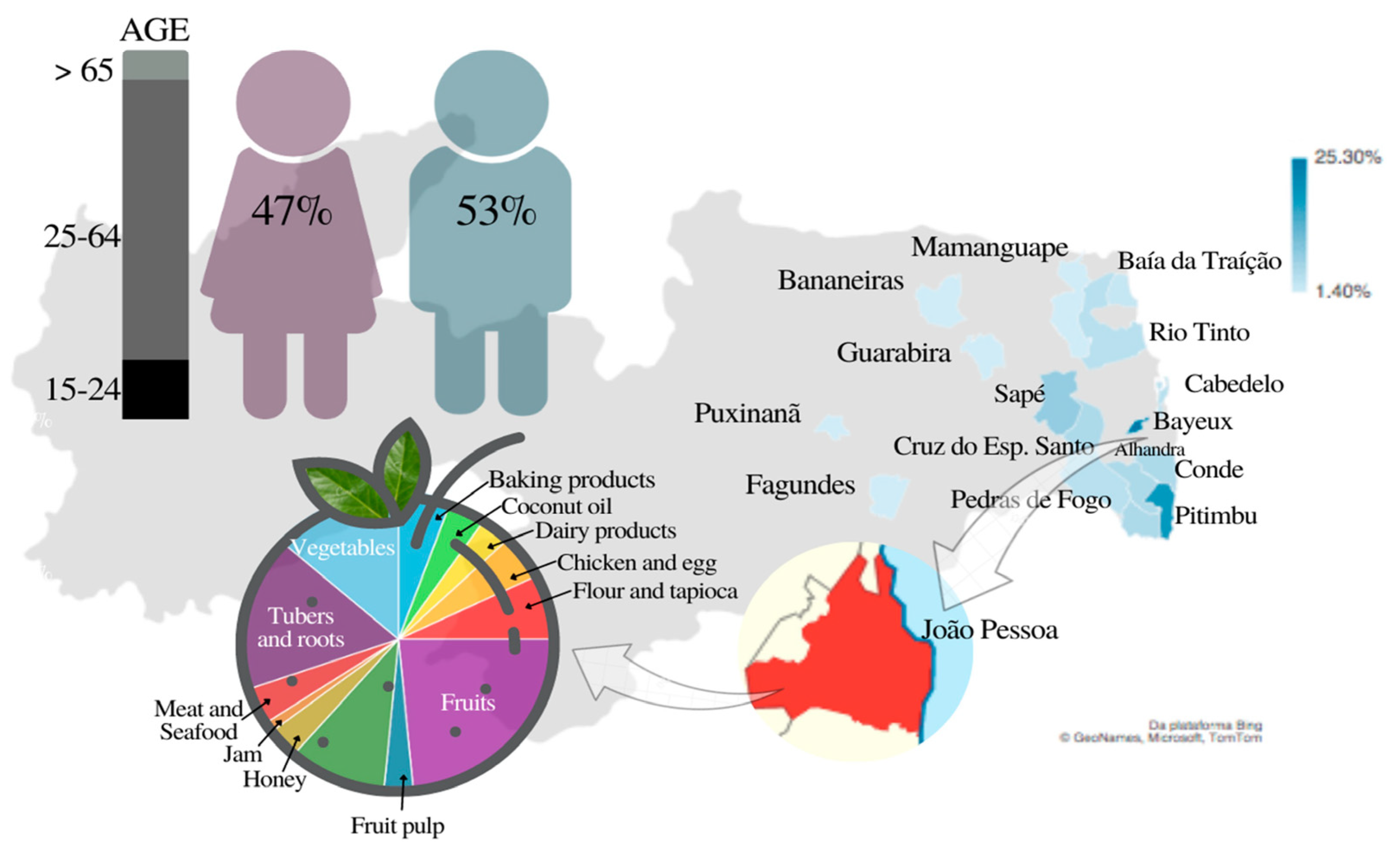
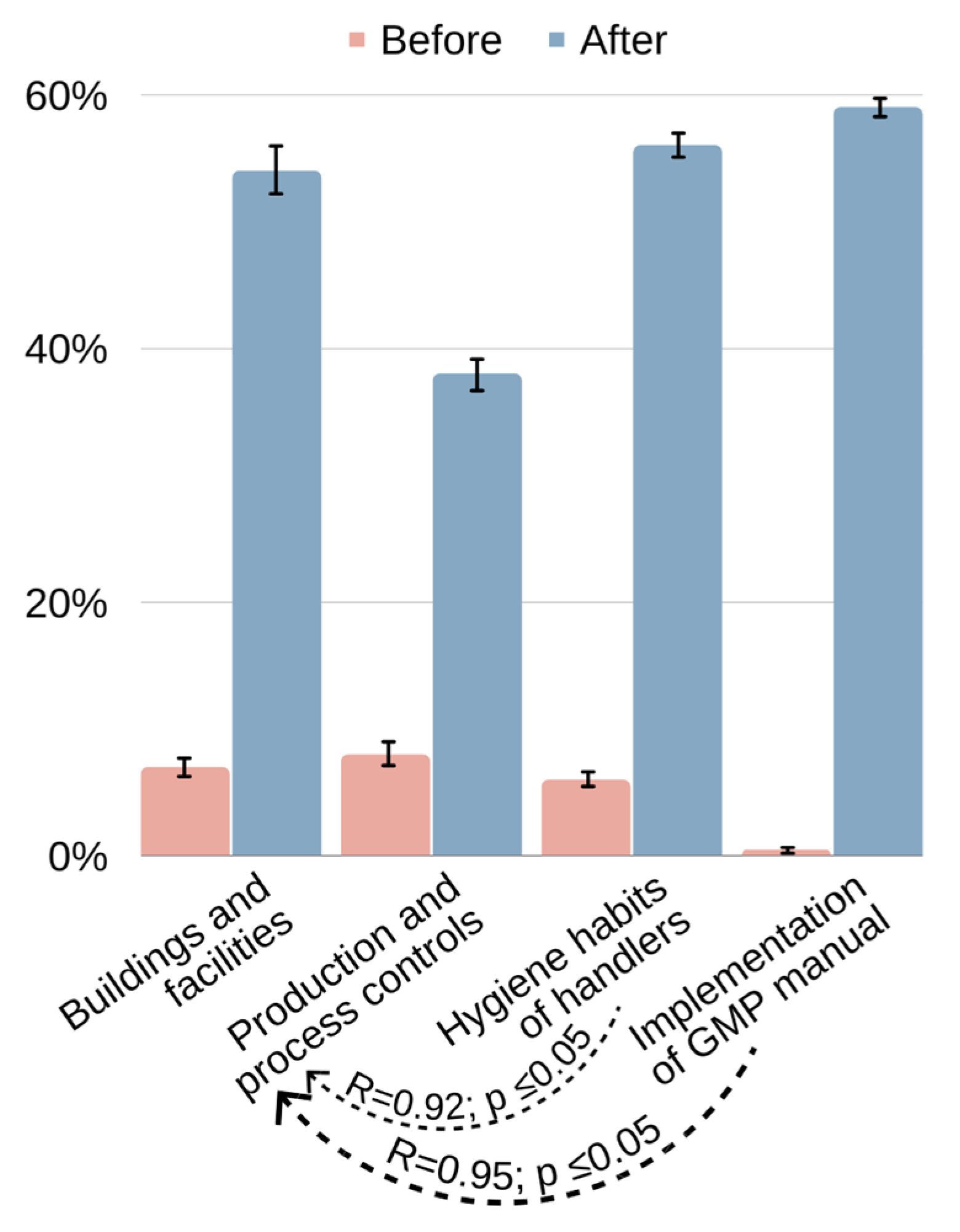
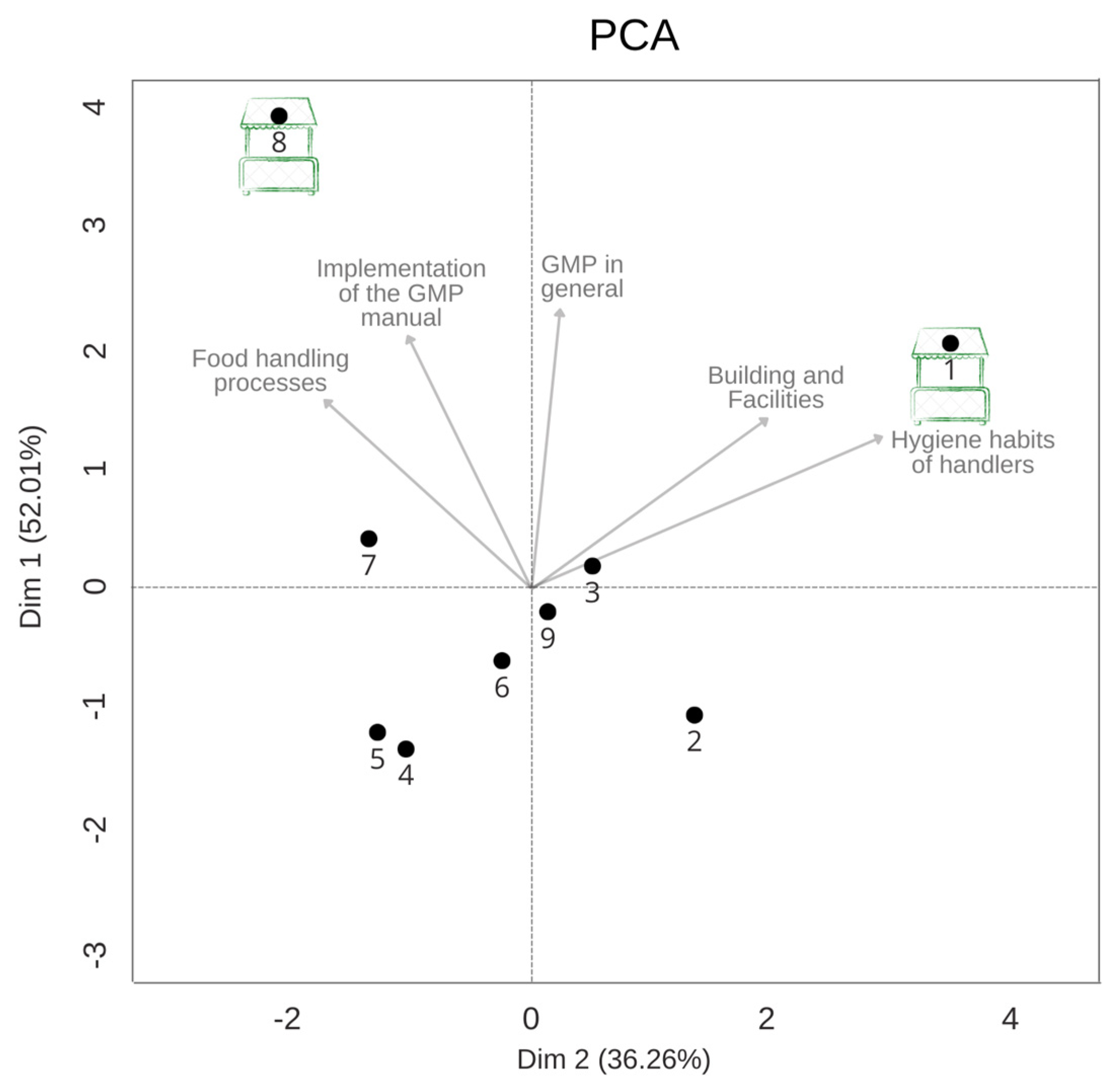
| Topics | Correctness Level of Responses | Chi-Square Test | |
|---|---|---|---|
| Before | After | p Value | |
| Prevention of foodborne diseases 1. Pathogenic bacteria present in food can cause serious illness and can be prevented by proper cooking, cleaning, and sanitation practices? 2. Salmonellosis is a foodborne illness caused by a bacterium and can be prevented by washing hands before handling food? 3. Listeriosis is a serious infection caused by a bacterium and can be prevented by proper food storage and handling techniques? 4. Bacillus cereus can cause food poisoning and can be prevented by properly reheating precooked foods? 5. Cross-contamination occurs when bacteria from one food is transferred to another and can be prevented by keeping raw and ready-to-eat foods separated? | 37 ± 2% | 88 ± 1% | ≤0.005 |
| Safe food handling 1. It is recommended to wash hands before handling food and after using the cell phone or going to the bathroom? 2. Using a cell phone while handling food is a safe practice? 3. Singing or talking near food presents no risks for food safety? 4. Keeping nails short and without nail enamel can help prevent food contamination? 5. Handling money while handling food can be a risk to food safety? | 67 ± 1% | 92 ± 6% | ≤0.005 |
| Food inspection and storage 1. Is it necessary to always verify the shelf life of stored food? 2. Should frozen foods be stored below −18 °C? 3. Should chilled foods be kept below −4 °C? 4. Is it acceptable to store food on the floor? 5. Is it acceptable to store food together with cleaning materials? | 75 ± 4% | 95 ± 3% | >0.005 |
| Analysis | Before | After | Friedman Test | ||||
|---|---|---|---|---|---|---|---|
| Median | Minimum | Maximum | Median | Minimum | Maximum | p | |
| Total coliforms (CFU/g or mL) | 2.40 | <1 | 4.89 | <1 | <1 | 3.7 | <0.001 |
| E. coli (CFU/g or mL) | <1 | <1 | <1 | <1 | <1 | <1 | 1.00 |
| Coagulase-positive Staphylococcus (CFU/g or mL) | 1.79 | <1 | 4.69 | <1 | <1 | 3.30 | 0.027 |
| Salmonella spp. | Absence | Absence | Absence | Absence | Absence | Absence | 1.00 |
| B. cereus (CFU/g or mL) | <1 | <1 | 2.00 | <1 | <1 | 1.88 | 0.458 |
| Molds and yeasts (CFU/g or mL) | 2.70 | <1 | 3.72 | <1 | <1 | 2.70 | <0.001 |
| L. monocytogenes | Absence | Absence | Absence | Absence | Absence | Absence | 1.00 |
Disclaimer/Publisher’s Note: The statements, opinions and data contained in all publications are solely those of the individual author(s) and contributor(s) and not of MDPI and/or the editor(s). MDPI and/or the editor(s) disclaim responsibility for any injury to people or property resulting from any ideas, methods, instructions or products referred to in the content. |
© 2023 by the authors. Licensee MDPI, Basel, Switzerland. This article is an open access article distributed under the terms and conditions of the Creative Commons Attribution (CC BY) license (https://creativecommons.org/licenses/by/4.0/).
Share and Cite
Rodrigues, N.P.A.; de Morais, M.S.; Bezerra, N.C.D.; Pereira, E.H.M.; Garcia Júnior, É.A.; Rodrigues, J.B.d.S.; de Paula Alexandrino de Oliveira, S.; de Souza, E.L. Development of an Educational Gamification Strategy to Enhance the Food Safety Practices of Family Farmers in Public Food Markets of Northeast Brazil: A Case Study. Foods 2023, 12, 1972. https://doi.org/10.3390/foods12101972
Rodrigues NPA, de Morais MS, Bezerra NCD, Pereira EHM, Garcia Júnior ÉA, Rodrigues JBdS, de Paula Alexandrino de Oliveira S, de Souza EL. Development of an Educational Gamification Strategy to Enhance the Food Safety Practices of Family Farmers in Public Food Markets of Northeast Brazil: A Case Study. Foods. 2023; 12(10):1972. https://doi.org/10.3390/foods12101972
Chicago/Turabian StyleRodrigues, Noádia Priscila Araújo, Mirella Silva de Morais, Nísia Carolina Damacena Bezerra, Erik Henrique Morais Pereira, Élcio Antônio Garcia Júnior, Jéssica Bezerra dos Santos Rodrigues, Sônia de Paula Alexandrino de Oliveira, and Evandro Leite de Souza. 2023. "Development of an Educational Gamification Strategy to Enhance the Food Safety Practices of Family Farmers in Public Food Markets of Northeast Brazil: A Case Study" Foods 12, no. 10: 1972. https://doi.org/10.3390/foods12101972
APA StyleRodrigues, N. P. A., de Morais, M. S., Bezerra, N. C. D., Pereira, E. H. M., Garcia Júnior, É. A., Rodrigues, J. B. d. S., de Paula Alexandrino de Oliveira, S., & de Souza, E. L. (2023). Development of an Educational Gamification Strategy to Enhance the Food Safety Practices of Family Farmers in Public Food Markets of Northeast Brazil: A Case Study. Foods, 12(10), 1972. https://doi.org/10.3390/foods12101972







